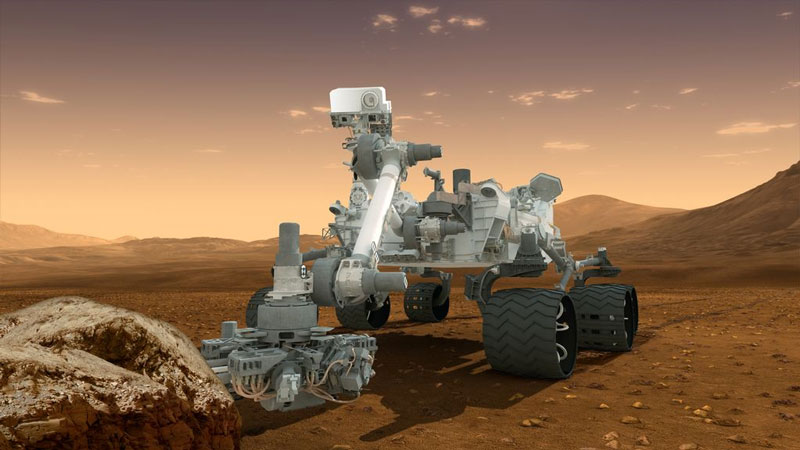Search for life on Mars
The most advanced American self-propelled probe will dig the surface of Mars to look for signs of life when it lands on the red planet next month.
Curiosity, the name of the self-propelled device of the US Aerospace Agency (NASA) flying to Mars, will land on the red planet on August 5. Where it will land is the Gale hole, a region dating back to 3.5 billion years on the surface of Mars. After approaching the surface of the planet, the device will drill, excavate and analyze rock samples in search of signs of life, Space reported.

Illustration of the spectacle of the Curiosity self-propelled device landing on Mars's surface on August 5.
'The current challenge of self-propelled probes on Mars is that they have never detected any organic compounds. We know that organic molecules can exist on that planet, but the machines have not found them in the soil, 'said Alexander Pavlov, a NASA expert.
Complex organic molecules, such as those with 10 or more carbon atoms, can be reliable evidence of the existence of living organisms in the past, because they are capable of creating creature.
NASA scientists believe that the opportunity to find organic molecules at a depth of 2 cm or less is almost zero. The top layer of Mars absorbs too much cosmic radiation over billions of years, so it is very likely that organic matter has been destroyed.
'But if you dig a few centimeters deeper, what Curiosity can do, it will most likely find simple organic molecules,' the researchers said.
Some previous studies have demonstrated that cosmic radiation can only reach a maximum depth of 1.5 m in the soil. So the organic molecules below that depth can exist for several billion years.
Even if Curiosity finds simple organic molecules, that finding doesn't mean that life forms have ever appeared on Mars.
"It is possible that simple organic substances come from other sources, such as meteorites and cosmic dust ," NASA researchers explained.
- Russia and Europe all look for life on Mars
- Discover the best location to search for life on Mars
- Signs of life on Mars
- Curiosity's ability to find life on Mars is decreasing
- Mars has life?
- Use 'scanning electron microscope' to search for biological samples on Mars
- Go to Mars, where is the spy ship landing?
- Life may have existed 700 million years on Mars
- Whether or not life on Mars is available only takes a few months to know
- Discovered two locations with potential to nurture life on Mars
- NASA revealed the mission of the next Mars probe
- Mars can nourish life
 Van Allen's belt and evidence that the Apollo 11 mission to the Moon was myth
Van Allen's belt and evidence that the Apollo 11 mission to the Moon was myth The levels of civilization in the universe (Kardashev scale)
The levels of civilization in the universe (Kardashev scale) Today Mars, the sun and the Earth are aligned
Today Mars, the sun and the Earth are aligned The Amazon owner announced a secret plan to build a space base for thousands of people
The Amazon owner announced a secret plan to build a space base for thousands of people Forget AI, the Age of Organic Intelligence Has Arrived: Bold Technology Makes Computer Chips Obsolete
Forget AI, the Age of Organic Intelligence Has Arrived: Bold Technology Makes Computer Chips Obsolete  New research reveals the hidden downsides of organic farming
New research reveals the hidden downsides of organic farming  'Building blocks of life' found on Mars
'Building blocks of life' found on Mars  NASA finds new form of 'building blocks of life' on Mars?
NASA finds new form of 'building blocks of life' on Mars?  Discovered organic molecules that can make life in the central Milky Way
Discovered organic molecules that can make life in the central Milky Way  Vietnam will have a gate to the origin of agricultural products
Vietnam will have a gate to the origin of agricultural products 